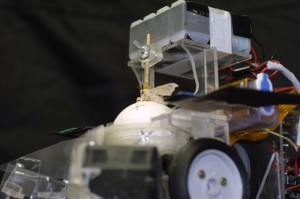Blueprint of an insect-mimetic robot Insect behavioral capability revealed by mobile robot

The reconstruction of sensory-motor mechanisms behind insect adaptive behaviors is expected to enable the development of biomimetic robots capable of adaptive behavior and effectively completing tasks. However, behavioral capabilities of the putative ‘insect-mimetic robot’ cannot be verified because insect sensory-motor mechanisms have not been extensively studied.
To evaluate the potential performance of an insect-mimetic robot, Prof. Kanzaki at the the University of Tokyo’s Research Center for Advanced Science and Technology (RCAST) and his colleagues have developed a mobile robot driven by a genuine insect (an insect-controlled robot) employing a male silkmoth as a driver, which can track the conspecific female sex pheromone. This odor tracking robot successfully localized an odor source even with a turning bias mimicking a motor failure of the robot. The compensation of the turning bias was achieved by simple and fast sensory-motor feedbacks of vision and olfaction. The evaluation of the insect-controlled robot will provide a ‘blueprint’ for biomimetic robots and is a significant contribution to the field of biomimetics.
Paper
Noriyasu Ando, Shuhei Emoto and Ryohei Kanzaki,
“Odour-tracking capability of a silkmoth driving a mobile robot with turning bias and time delay”,
Bioinspiration & Biomimetics 8 2013: 016008, doi: 10.1088/1748-3182/8/1/016008.
Article link
Links
Research Center for Advanced Science and Technology
Kanzaki-Takahashi Laboratory, Research Center for Advanced Science and Technology








